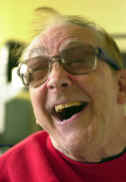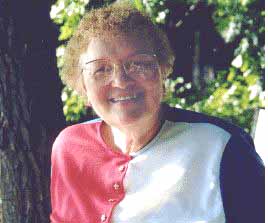In this issue you will find:
- Is ham radio & the Handiham System still relevant?
- In AT: The Dragon NaturallySpeaking 9 Review, Part Two
- Last call: California Radio Camp
- Handiham office move on Thursday
- In RekkyTec: Podclass debuts, Bright comet streaks through sky tonight
...and lots of other stuff. Tune in today!
 Picture: Dr. Tom Linde, KZ0T, has taken life by the horns and wrestled it down! (Bryan Watt photo)
Picture: Dr. Tom Linde, KZ0T, has taken life by the horns and wrestled it down! (Bryan Watt photo)
Last week, we talked about the early years of the Courage Handiham System. In those years, people with disabilities were often shut-ins, technology was pretty limited, and the Internet did not exist. Furthermore, advocacy for people with disabilities was, at best, on the back burner.
Today, although the situation is far from perfect, people with disabilities have far more resources at their command. Motorized wheelchairs help people get around. Public transportation is designed to accommodate wheelchairs, and it is now normal to see "curb cuts" that allow people to navigate sidewalks in metropolitan areas. The workplace has become more disability-friendly as well, and attitudes have changed to an expectation that people with disabilities and sensory impairments will live a full, productive lifestyle. This is due in no small part to an increase in awareness about disability issues, and, of course, advocacy.
Technology has improved at lightning speed, and continues to evolve daily. Personal computers and the Internet have made many tasks, including worldwide communications, much easier for everyone, not only people with disabilities.
What does this mean for the Courage Handiham System? What about ham radio in general?
Ned Carmen's original vision was to "open a window to the world for people with disabilities via amateur radio". Doesn't the Internet open a window to the world for everyone? And since people with disabilities are no longer shut-ins, do they even need the communications and networking potential of amateur radio in the first place?
The answer is a resounding... maybe. After all, it depends on a person's interests, abilities, and (in these busy days) spare time. Let us consider some of the advantages that an amateur radio license has to offer:
- By studying electronics, FCC rules and regulations, operating procedures, and the like, people who decided to get an amateur radio license share a common experience. All of us have had to practice and study to pass an examination. This creates a bond and an understanding not unlike membership in a fraternal organization.
- Amateur radio offers other opportunities, too... getting one's license is only the first step. After that there is plenty of potential to continue in a lifelong learning activity that can include electronics, even advanced electronics and design, organizing and managing group activities, learning about and writing software, building computer systems, and much, much more.
- There is also a competitive aspect to amateur radio operating. This is not everyone's cup of tea, but for a person with a disability who has a competitive spirit, contesting via amateur radio is a healthy, safe activity with a level playing field, where people with disabilities have the same chance of success as anyone else.
- Public service and amateur radio remain, as they have over many decades, a staple for many operators. Helping one's community, volunteerism, and amateur radio go hand-in-hand.
- Technology is changing rapidly, and amateur radio publications and organizations, including local ham radio clubs and the Courage Handiham System help to keep amateur radio operators aware and up-to-date. This includes, for Courage Center and the Handiham System, a mission to help people with disabilities understand assistive technology.
- There is a social aspect to amateur radio that cannot be overlooked. Amateur radio operators gather, in person at club meetings and special events, ham radio conventions, and on the air. Making friends and keeping in touch with them will always be a part of amateur radio activities worldwide. Friendships bridge cultures, national boundaries, race, religion, and politics.
Now, let's get to that resounding "maybe" that I talked about earlier. We recognize that amateur radio is not for everyone. Some people are simply not interested in technology or radio. Fine, they will find some other activity that suits them. There are, after all, many activities open to people with disabilities that were not available 40 years ago, and there is certainly a more accessible world out there. On the other hand, there are people with severe disabilities or multiple disabilities who, in spite of all of the advances made in assistive technology and advocacy for people with disabilities, still remain somewhat isolated. These people may benefit from the challenge and friendship potential of amateur radio. Then there are the people who, whether they have a disability or not, simply do not understand what amateur radio is all about. They may or may not be interested, but there is really no way to find out unless they have a way of learning what amateur radio is about in the first place. I'm going to drop a final category of potential ham radio operator in here, and that is the person who thinks they understand what ham radio is about but they really have a misguided notion. Let's talk about each of these in turn:
The person who is not interested in technology or radio: If a person tells you that they are "not interested", I think you have to respect that. On the other hand, if they are willing to visit your local radio club or attend a field day session just for fun, they may become interested. At Handihams, we sometimes hear about people who "would really enjoy ham radio" from a well-meaning person who thinks cousin Joe would be thrilled to get a ham radio license just as they were. We dutifully send out information, but cousin Joe really isn't interested in the first place, and that is that. On the other hand, maybe we will hear from cousin Joe someday -- we are always hopeful. The main thing is to respect people's feelings and interests and not to behave like a high-pressure salesman!
People with disabilities who are still somewhat isolated: This kind person is really a pretty good prospect. Ned Carmen's "open a window to the world" mission can still apply, because this potential handiham member may experience limited opportunities for competition, friendship building, public service, and other things that ham radio can offer quite easily.
People who do not understand what amateur radio is all about: Here we are talking about most of the members of the general public. Many have heard about "ham radio", but that is just about all they know. They have never taken the time to think about it nor have they been exposed to any kind of amateur radio events or experience. This is where ham radio organizations like the Courage Handiham System and ARRL can find fertile ground to recruit and grow new amateur radio operators! The question is how, and the answer is usually marketing... the website, materials that can be used for club programs and Hamfests, appearances before public service and fraternal organizations, good press, and (probably most important) word-of-mouth. Our handiham members can spread the good word by letting others know about the fun of amateur radio.
People who think they understand what ham radio is all about but really don't: This kind of potential ham is really a challenge. They may have dismissed ham radio as something they would never want to do because they don't understand what it is all about. Typical points of confusion are that ham radio is like CB radio or that they will have to learn Morse code. They may believe that one has to be an engineer or mathematician to pass the exam. Perhaps they think they will have to travel hundreds of miles to take an exam. Maybe they have been exposed to only one aspect of amateur radio and don't know about others; one example would be a person who thinks amateur radio is all about sitting in one's basement and working DX, when in fact that person may really be quite interested in amateur radio's public service activities like SKYWARN, if only they knew more about the full spectrum of what amateur radio has to offer.
Do you see where I'm going with this? Amateur radio and the Courage Handiham System are as relevant to people with disabilities today as they ever were, but society and technology have changed relentlessly over the past four decades. We like to think that we have kept up, but it isn't easy... for us or for any other amateur radio organization faced with competition from the many other distractions people have in their lives today. On the other hand, you have to realize that this is a major societal trend that affects other activities and not just amateur radio. We hear that there is a decline in participation in bowling leagues, hunting and fishing, service organizations... the list seems to be endless. Video gaming, Internet browsing, and sitting in front of plasma television sets with about a million channels to choose from is bound to have some sort of effect. However, we believe that amateur radio is and remains a solid, viable lifelong learning activity that simply sitting in front of a screen cannot match.
To be continued next week.
Would you like to read Dr. Tom Linde's book, "I Am Not What I Am"? You can borrow it in audio format from the handiham audio library if you are a member.
 In this issue you will find:
In this issue you will find: Picture: Dr. Tom Linde, KZ0T, has taken life by the horns and wrestled it down! (Bryan Watt photo)
Picture: Dr. Tom Linde, KZ0T, has taken life by the horns and wrestled it down! (Bryan Watt photo) Ned enlisted the help of a group of local nuns, the Sisters of St. Francis, on April 30, 1967. Although their first action was as weather watchers during a thunderstorm that passed through Rochester that day, the Sisters were committed to helping Ned with his new project, and several received their licenses. Among them was Sister Alverna O'Laughlin, WA0SGJ, the former Educational Coordinator for the HANDI-HAM System, now retired.
Ned enlisted the help of a group of local nuns, the Sisters of St. Francis, on April 30, 1967. Although their first action was as weather watchers during a thunderstorm that passed through Rochester that day, the Sisters were committed to helping Ned with his new project, and several received their licenses. Among them was Sister Alverna O'Laughlin, WA0SGJ, the former Educational Coordinator for the HANDI-HAM System, now retired.